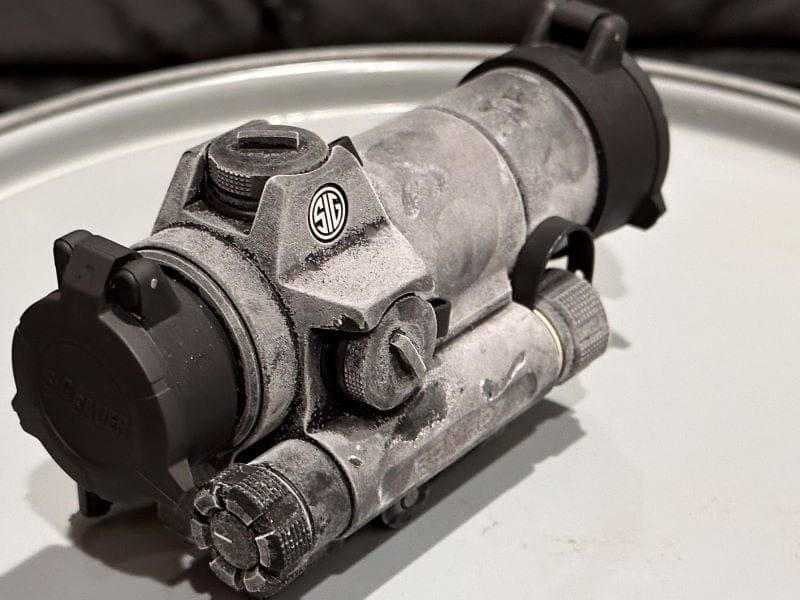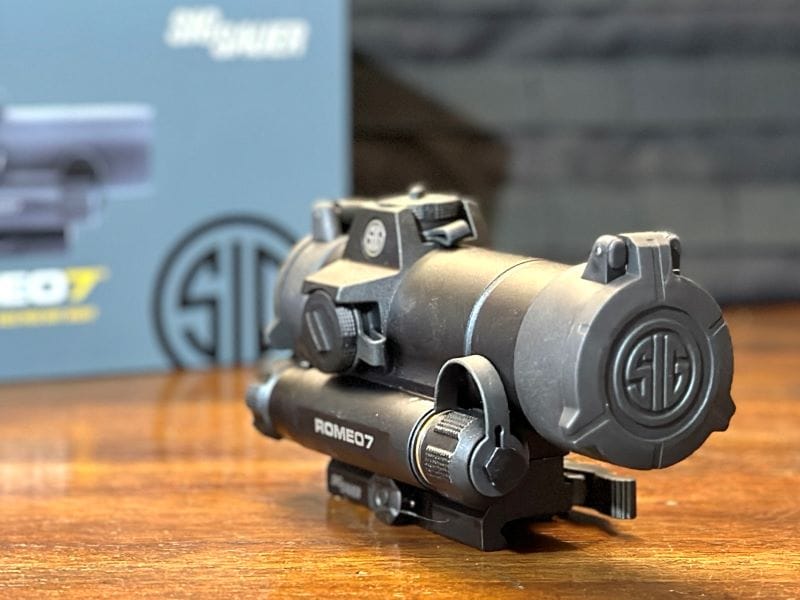Aimpoint ACO and Sig Romeo 7 are great optics for the price. But is one better than the other? Back in the day, your options were limited. You could pick from a $50 optic from Target. Or, at a gun store, you could find an Aimpoint, Trijicon, or EOTech that would cost well over a grand. Having an optic that costs the same or more than the rifle it sits on was a bragging rights privilege, but not so much today. People want something functional, durable, and, most importantly, affordable.

For the guy who buys one rifle for the apocalypse and is content with that, it’s not as hard to pull off. But, if you own multiple rifles, $1,000+ optics are hard to pull off. This leaves us non-rich folk looking for something that isn’t made of plastic parts that we can still afford. Both the Aimpoint ACO (Aimpoint Carbine Optic) and Sig Romeo 7 red dot fall smack dab in our target range. I’ve had both optics for a while, and both are impressive red dots for such a reasonable price.
Determining which one is right for you could be challenging because there isn’t one that stands out over the other. Both have a few advantages and disadvantages. I don’t like leaving reviews with “it’s all personal preference,” so I will tell you which one I prefer at the end. But I will say it’s not going to be a landslide winner.
Sig Romeo 7 Red Dot
Sig Sauer has been in the gun business for a long time, and they are currently the ones making the standard issue sidearms for the US military. They also jumped into the optics market and haven’t slowed down any. Most of their red dots fall under the Romeo line. The Romeo 7 is a full-size 2 MOA reticle optic about the size of an Aimpoint Comp. In past reviews, I’ve frozen it, soaked it in water, and baked it in the oven at 150 degrees. I also dropped it repeatedly from shoulder height onto concrete.
What comes in the box?
There are several features I like about the Romeo 7. First is the battery. It uses an AA battery, which is probably the most common battery on the planet. I always have one in a drawer somewhere in my house because clocks, kids’ toys, TV remotes, and everything else require AA batteries. I like optics that use common household batteries, so this is a big plus for me. Some other types of batteries may not be hard to find, but they’re not the kind you have lying around either.

- Romeo 7 red dot
- Two mounting brackets
- Kill flash
- Battery
- Lens covers
- Wrench for zeroing
- Cleaning cloth.
Ease of operation
Some optics try too hard to give you options and make the optic programable. But this means you must remember how to program it. The Romeo 7, however, has one simple dial for on and off. If you turn it on and leave it, it will shut off on its own and turn back on when it senses movement. The power dial is about the same as an Aimpoint. It’s a larger dial on the upper right side that turns to the right. To increase the brightness, keep turning it to the right. Turn it to the left, and it’s back off. But, with the built-in auto on and off feature, you can leave it on and ready to go when you need it, and it will shut off on its own. This also helps preserve battery life when you forget to turn it off after using it.
Aimpoint ACO red dot
Now, we get to the Aimpoint ACO. One of the biggest features this red dot has going for it is the name. While other optics must prove their durability and try to fight in a crowded red dot world, Aimpoint doesn’t. What is interesting about the ACO is that it retails far below the other optics out there.

What features does the ACO have?
The ACO comes with a multi-coated lens to keep glare from being an issue during the day. It has 10 brightness settings and a power dial on the upper right-hand side. Aimpoint didn’t put a lot of bells and whistles on the ACO and opted to keep it simple and rugged like their other optics. It is submersible for up to 15 feet and is shockproof, which is something all optic manufacturers claim. The difference is Aimpoint optics have been tested in the field and proven to be nearly indestructible. Of course, the ACO has not been used by the military, as it was designed for civilian use.

Which one is the best deal?
I’ll get right to the point. For me, the Aimpoint ACO is the best deal overall. You don’t get as many accessories, and the ACO costs more. But the quality is probably higher. This doesn’t mean the Romeo 7 isn’t a good quality optic for the price, though. I’ve had mine for a while, and it’s held up to everything I’ve put it through. I guess my opinion is based on speculation. If I were to start beating the optics with a bat until one stopped working, I’m assuming the Aimpoint would hold out longer.
Sig’s Romeo 7 retails for $199, making it a super deal for that price. It comes with a lot of accessories and is a great optic for the money. If you want a great optic for the best price, I would go with the Romeo 7. But the Aimpoint ACO retails for $350, so if that’s not out of your price range, it could be an even better deal. In my opinion, you can’t really pick the wrong one between these two. I use my Romeo 7 regularly, and it’s always worked great for me. As for the Aimpoint – well, it’s an Aimpoint. They’re solid. Regardless, find the one you like and don’t look back. You’ll have a great optic either way.


